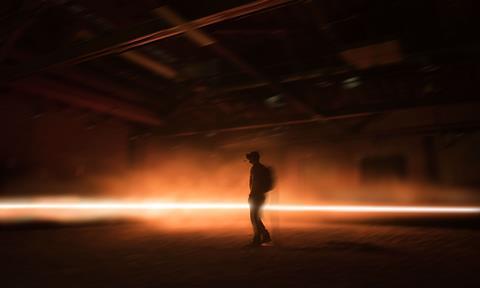The big-scale VR project is impressive, but does it represent a step forward for the medium?

Screen was among the first press in Cannes to experience four-time Oscar-winner Alejandro González Iñárritu’s virtual reality installation Carne y Arena (Virtually Present, Physically Invisible), which is the first VR project to play in the festival’s Official Selection.
Housed in a hangar at a nearby airfield, the six-and-a-half minute experience places the viewer into the virtual shoes of a migrant attempting to cross the border from Mexico into the US. It’s impressive, in terms of scale and technology, and immersive, fully encapsulating the user in the dramatic plight.
It plays here in Cannes until May 28 before moving to the Fondazione Prada art institution (who financially backed the installation with Legendary Entertainment) in Milan from June until December 2017. The Revenant producer Mary Parent and immersive entertainment studio ILMxLAB worked on the project.
When placed in contrast with the usual Cannes screening experience of sitting in a darkened room, staring up at a large screen, many will find the Carne y Arena a refreshing change to their routine.
The user initially enters a prison-like waiting area, where they are kept in isolation for up to 10 minutes and asked to remove their shoes and socks before being ushered into the main staging area by a siren and accompanying flashing red light.
Inside, where the ground is covered in coarse sand, the user dons an Oculus Rift headset, headphones, and a computer cleverly disguised in a rucksack, before being transported to a desert landscape. The arena is mapped by the VR technology, allowing the user free movement around the space.
There, they join a group of migrants attempting to cross the border into the US, evading border patrol and battling with the elements along the way.
Director Iñárritu says he has been working on the experience for several years, “During the past four years in which this project has been growing in my mind, I had the privilege of meeting and interviewing many Mexican and Central American refugees.”
He also reveals that the characters in the piece are played by people who have genuinely been through those experiences, “Their life stories haunted me, so I invited some of them to collaborate with me in the project.
“My intention was to experiment with VR technology to explore the human condition in an attempt to break the dictatorship of the frame - within which things are just observed - and claim the space to allow the visitor to go through a direct experience walking in the immigrants’ feet, under their skin, and into their hearts.”

The experience
While the staging of Carne y Arena is inarguably impressive, and the visuals shot by regular Iñárritu collaborator Emmanuel Lubezki are gorgeous, in comparison with other high-end VR projects around it comes up slightly short.
The shortfall is its interactivity. At first, the viewer wanders around the terrain and approaches the various characters on screen, but when it becomes apparent that this is a passive experience, the user feels like an invisible entity and instead of participating, merely sits back and lets events unfold in front of them.
A surprise, fleeting moment of interactivity with a police officer towards the end provides a brief moment of elevated immersion, but only serves as a reminder that the entire project is lacking depth of user experience.
As the VR debate about whether the medium sits more comfortably in the realm of films or games continues to rage, Carne y Arena sets out its stall as a spectator experience more closely aligned to film, but closest to an art installation. It’s upcoming residence at the art institution in Milan feels like a natural fit.
The project has artistry, no doubt injected by the auteur hand of Iñárritu, but it has extremely limited commercial potential due to the large-scale nature of the installation and the fact that only one user can experience it at a time.
Carne y Arena is a well-made VR project about a worthy cause, but the emerging medium still has strides to make before it will feel truly embedded in the Cannes programme.







![The Brightest SunScreen[Courtesy HKIFF]](https://d1nslcd7m2225b.cloudfront.net/Pictures/274x183/3/5/0/1448350_thebrightestsunscreencourtesyhkiff_312678.jpg)

















No comments yet